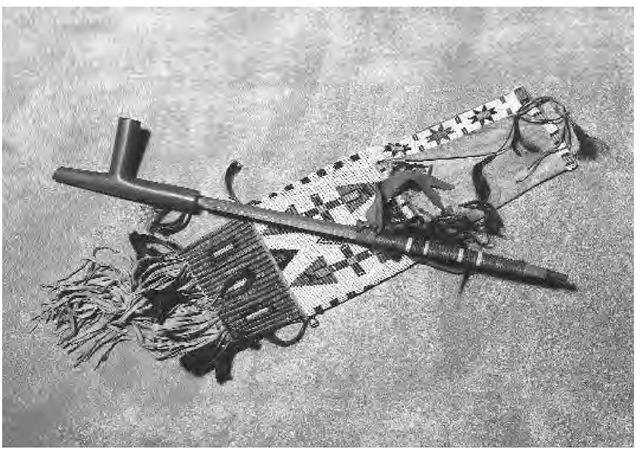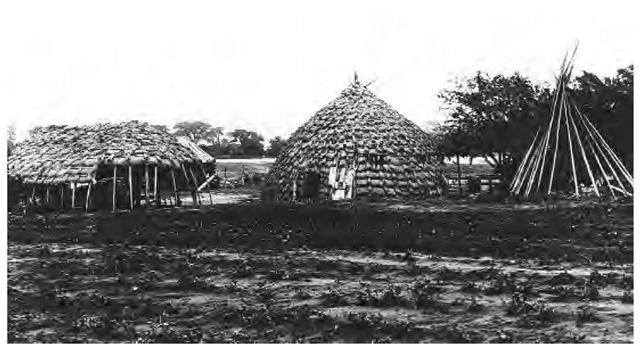Wichita (Wi chi ta) is the name of one band of a loose confederacy of several tribes living in separate villages. The Spanish called them Jumanos. They have also been called Black Pawnee as well as by the names of related tribes such as Waco, Tawakoni, Tawehash, and Akwits. Their self-designation was Kitikiti’sh, meaning "Men."
Location Wichitas lived in central and southeast Kansas, along the Great Bend of the Arkansas River, in the mid-sixteenth century. They migrated to the Kansas-Oklahoma border area in the early eighteenth century and to the Red River region of southeastern Oklahoma in the late eighteenth century. By the mid-nineteenth century they had moved to southwestern Oklahoma. Today, most live in Caddo County, Oklahoma.
Population The Wichita population (including associated tribes) was at least 15,000 in the mid-sixteenth century. That number had dwindled to about 3,200 in the late eighteenth century. In the 1890s there were 153 Wichitas. There were 1,764 enrolled tribal members in 1993.
Language Wichita is a Caddoan language.
Historical Information
History The people who were to become the historic Wichita split apart from the proto-Pawnee about 1,500 years ago. These people may have lived near the Washita River of western Oklahoma about 1,000 years ago. They probably moved north from eastern Texas in the fourteenth century to the Great Bend of the Arkansas River. There they were visited by Francisco Vasquez de Coronado in 1541, when he referred to their villages as Quivira. The people acquired horses by 1700.
During the eighteenth century, under pressure from the well-armed Osage, the Wichita began moving south toward Oklahoma and Texas. Trade with the French began after 1720; with the southern Pawnee, the Wichita dominated the gun trade out of New Orleans. However, in the mid- to late eighteenth century the French trade was suspended while the Wichita were engaged in periodic wars with the Spanish.
A severe smallpox epidemic crippled the people in 1801. Osage and non-Indian raids depleted their population even further in subsequent years. An 1835 treaty between the United States and the Wichita, Comanche, and several eastern tribes marked the first time that the Wichita were officially referred to by that name.
In 1854, several Wichita bands settled with the Shawnees and Delawares on a reservation on the Brazos River, although the non-native Texans soon forced them out. The United States established a Wichita reservation in Indian Territory (Oklahoma), south of the Canadian River, in 1859. Wichitas left the Indian Territory for Kansas (near present-day Wichita) during the Civil War but returned in 1867. They formally ceded all their nonreservation land in 1872 in exchange for a 743,000-acre reservation along the Washita River. However, the agreement was never ratified by Congress. Tribal lands were allotted in 1901. The government paid them $1.25 an acre for the "excess" and then opened that land to non-Indian settlement.
Religion Kinnikasus was the great creator. Other deities were recognized, too, particularly those related to the celestial bodies. The people held a deer dance three times a year. They also performed a calumet (pipe) ceremony. There were many secret societies, for both men and women, each with its own ceremonies and dances.
Government The Wichita were traditionally a loose confederation of several bands or tribes occupying independent villages. A chief and a subchief, chosen by a council of warriors, presided over each village.
Customs The smallest economic unit was the family. Descent was matriarchal. Corpses were buried in a nearby hill with various goods associated with their earthly activities. Mourners cut their hair and gave away some of their possessions.
Dwellings The various Wichita bands lived in separate villages near rivers. In the sixteenth century, settlements consisted of up to 1,000 round houses, each 15-30 feet in diameter and built of a pole framework tied with branches or reeds and thatched with grass. The houses had two doors, a smoke hole in the center, and sleeping platforms along the walls. The people also used ramadas in summer and for some occasions as well as skin tipis during the fall buffalo hunts.
Diet Women grew corn, beans, squash, and tobacco. Crops were stored in underground caches. Pumpkins were cut, dried, and woven into mats for storage. Women also gathered foods such as plums, grapes, and nuts. Men hunted buffalo, usually twice a year— in June and following the harvest—after they obtained horses. They also hunted deer, elk, rabbit, antelope, and bear.
A calumet and a beaded pouch for carrying it. These pipes were important in Plains ceremonials.
Key Technology Wichitas made items typical of agricultural societies, such as pottery, manos, and metates.
Trade They traded agricultural goods to nomadic tribes in exchange for animal goods. Although the two societies did communicate, there was little trade with the New Mexico pueblos. After 1720, the Wichita acted as intermediaries between the French (tools, guns) and the western nomadic tribes (hides, furs). Following a 1746 friendship treaty, they traded guns to the Comanche for horses, which went eventually to the plantations on the lower Mississippi or southeastern states.
Notable Arts Native artists focused on making pottery and clothing as well as some items of personal ornamentation.
Transportation The people acquired horses by 1700.
Dress Women made all clothing of animal skins. Both sexes practiced extensive body and facial tattooing.
War and Weapons War horses wore leather armor. Although the Wichita were generally a peaceful people, they did fight the Osage and the Apache. After 1746 they were allied with the Comanche.
Contemporary Information
Government/Reservations The Wichita tribe owns 10 acres of land and holds another 2,400 acres in joint trust with Caddos and Delawares in Caddo, Canadian, and Gray Counties, Oklahoma. They elect seven tribal officers. Tribal headquarters is located near Anadarko, Oklahoma.
Economy The tribal government and the local clinic are major employers. The tribe also collects license and vendor fees.
Three kinds of Wichita shelters are depicted in this 1898 photograph: a thatched structure for cooking, a grass house for sleeping, and a frame for a tipi used on buffalo hunts.
Legal Status The Wichita Tribe is a federally recognized tribal entity.
Daily Life The native language is almost extinct, although there are programs designed to save it. Most Wichitas are Baptists; some are members of the Native American Church. The Caddo-speaking tribes of Texas have a long history of ritual peyote use. There is an annual dance in August and an annual large-scale visit with the Pawnee, each tribe taking turns hosting the event.


